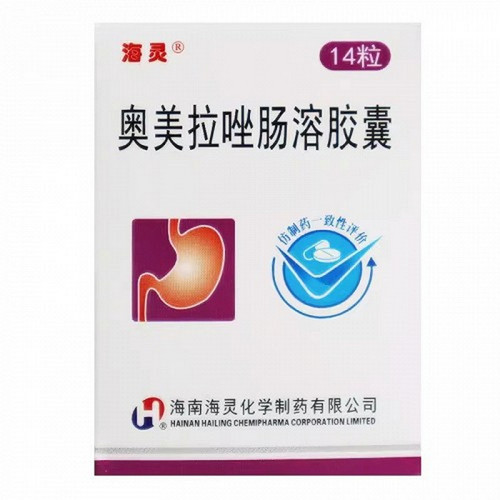Product Overview
[Drug Name]
Trade Name: Xinao
English Name: Omeprazole Enteric-Coated Capsules
Chinese Pinyin: Aomeilazuo Changrongjiaonang
[Ingredients]
The main ingredient of this product is omeprazole. Its chemical name is 5-methoxy-2-{[(4-methoxy-3,5-dimethyl-2-pyridyl)-methyl]-sulfoxide}-1H-benzimidazole. Molecular formula: C₁ₐH₁₉N₃O₃S. Molecular weight: 345.41
[Properties]
This product contains white or off-white enteric-coated granules.
[Indications]
Indicated for gastric ulcers, duodenal ulcers, stress ulcers, reflux esophagitis, and Zollinger-Ellison syndrome (gastrinoma).
[Dosage and Administration]
Oral administration, do not chew.
1. Peptic ulcer: 20 mg once, 1-2 times daily. Take orally in the morning or once in the morning and evening. The treatment course for gastric ulcers is usually 4-8 weeks, and for duodenal ulcers is usually 2-4 weeks.
2. Reflux esophagitis: 20-60 mg once or twice daily. Take orally in the morning or once in the morning and evening. The treatment course is usually 4-8 weeks.
3. Zollinger-Ellison syndrome: 60 mg once daily. The total daily dose can be adjusted to 20-120 mg depending on the condition. If the total daily dose exceeds 80 mg, it should be taken in two divided doses.
[Adverse Reactions]
Common adverse reactions of this product include headache, diarrhea, nausea, vomiting, constipation, abdominal pain, and bloating. Occasionally, dizziness, drowsiness, fatigue, sleep disturbances, paresthesia, rash, itching, urticaria, and abnormal liver function tests may occur. Rarely, hyperhidrosis, peripheral angioedema, hyponatremia; angioedema, fever, and anaphylactic shock; leukopenia, thrombocytopenia, granulocytosis, and pancytopenia; reversible confusion, irritability, depression, aggression, and hallucinations; gynecomastia; dry mouth, taste disturbances, stomatitis, and candidiasis; alopecia, photosensitivity, and erythema multiforme; hepatic encephalopathy (in patients with preexisting severe liver disease), icteric or non-icteric hepatitis, and liver failure; bronchospasm; arthralgia, myalgia, and muscle fatigue; interstitial nephritis; and blurred vision.
[Contraindications]
This product is contraindicated in patients with allergies, severe renal impairment, and infants.
[Precautions]
1. Do not use for more than 7 days. If symptoms persist or disappear, consult a physician or pharmacist. 2. Do not use again within 2 months. If symptoms recur, seek medical attention immediately. 3. Do not use this product in the following situations: difficulty or pain swallowing; vomiting blood; or bloody or melena. These may be signs of a serious condition; consult a physician. 4. Patients with impaired liver function or abnormal blood counts should use this product under the supervision of a physician. 5. If heartburn persists or worsens, discontinue use and seek medical attention. 6. Children should only use this product under the supervision of a physician. 7. Use with caution during pregnancy and lactation. 8. If overdose or serious adverse reactions occur, seek medical attention immediately. 9. Do not use if allergic to this product. Use with caution if allergic. 10. Do not use if the product's properties change. 11. Keep this product out of reach of children. 12. Children must be supervised by an adult before use. 13. If you are currently using other medications, consult a physician or pharmacist before using this product.
[Special Use Groups]
Precautions for Children:
Not for use in infants and young children
Precautions for Pregnancy and Lactation:
Although this product has not been shown to cause teratogenicity in animal studies, it should generally not be used in pregnant women, and should be used with caution in lactating women.
Precautions for Elderly:
Unknown.
[Drug Interactions]
1. Avoid concomitant use with oral imidazole antifungals such as ketoconazole, itraconazole, miconazole, and fluconazole.
2. Concomitant use of omeprazole and clarithromycin may increase the incidence of central nervous system (primarily headache) and gastrointestinal adverse reactions.
3. Avoid concomitant use with diazepam (Valium), phenytoin, warfarin, nifedipine, digoxin, cisapride, quinidine, cyclosporine, caffeine, and theophylline.
4. Concomitant use with other medications may cause drug interactions. Consult your physician or pharmacist for details.
[Pharmacological Actions]
Proton pump inhibitors. This drug is a fat-soluble, weakly alkaline drug that tends to concentrate in acidic environments. Therefore, after oral administration, it is specifically distributed in the secretory tubules of the gastric parietal cells. In this highly acidic environment, it is converted into its active sulfenamide form. It then irreversibly binds to the sulfhydryl group of the H+,K+-ATPase (also known as the proton pump) in the secretory membrane of the parietal cells via a disulfide bond, forming a sulfenamide-proton pump complex. This inhibits the enzyme's activity and blocks the final step in gastric acid secretion. Therefore, this drug has a strong and long-lasting inhibitory effect on gastric acid secretion caused by various causes.
[Storage]
Store tightly in a dry place.
[Strength]
20 mg
[Packaging Size]
20 mg x 14 s
[Expiry Date]
24 months.
[Approval Number]
National Medicine Standard No. H20045335
[Manufacturer]
Company Name: Shanghai Xinyi Wanxiang Pharmaceutical Co., Ltd.






